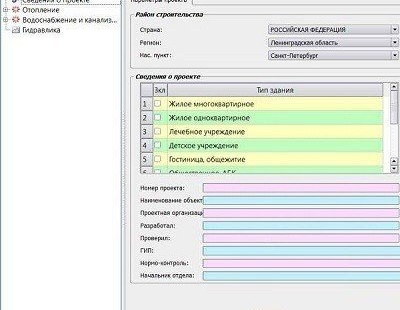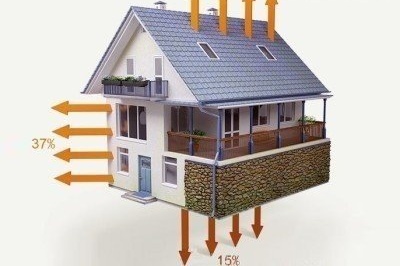Thermal calculation of a heating system: formulas, reference data and a specific example

The thermal calculation of the heating system seems to most easy and not requiring much attention. A huge number of people believe that the same radiators should be chosen based on only the area of the room: 100 W per 1 sq. M. Everything is simple. But this is the biggest mistake. You can not be limited to such a formula. The thickness of the walls, their height, material and much more are of importance. Of course, you need to allocate an hour or two to get the right numbers, but this is within the reach of everyone.
Initial data for designing a heating system
To calculate the heat consumption for heating, you need, firstly, a house project.

The house plan allows you to get almost all the source data that is needed to determine heat loss and load on the heating system
It should contain the internal and external dimensions of each room, windows, external doorways. Internal doors are left unattended because they do not have any effect on heat loss.
Secondly, you will need data on the location of the house in relation to the cardinal points and the construction area - the climatic conditions in each region are different, and what is suitable for Sochi cannot be applied to Anadyr.
Thirdly, we collect information about the composition and height of the outer walls and the materials from which the floor (from the room to the ground) and the ceiling (from the rooms and to the outside) are made.
After collecting all the data, you can begin to work. Calculation of heat for heating can be performed according to the formulas for one to two hours. You can, of course, take advantage of a special program from Valtec.

To calculate the heat loss of the heated rooms, the load on the heating system and the heat transfer from the heaters, it is enough to enter only the initial data into the program. A huge number of functions make it an indispensable assistant for both the foreman and the private developer
It greatly simplifies everything and allows you to get all the data on heat loss and hydraulic calculation of the heating system.
Formulas for calculations and reference data
Calculation of the heat load for heating involves the determination of heat loss (Tp) and boiler capacity (Mk). The latter is calculated by the formula:
Mk = 1.2 * Tpwhere:
- Mk - thermal performance of the heating system, kW;
- Tp - heat loss at home;
- 1.2 - safety factor (20%).
A twenty percent safety factor allows you to take into account a possible pressure drop in the gas pipeline during the cold season and unforeseen heat losses (for example, a broken window, poor-quality thermal insulation of entrance doors or unprecedented frosts). It allows you to insure yourself against a number of troubles, and also makes it possible to widely regulate the temperature regime.
As can be seen from this formula, the boiler power directly depends on heat loss. They are not evenly distributed throughout the house: about 40% of the total amount falls on the external walls, 20% on the windows, 10% gives the floor, 10% the roof. The remaining 20% disappears through the doors, ventilation.

Poorly insulated walls and floors, cold attics, ordinary glazing on windows - all this leads to large heat losses, and, consequently, to an increase in the load on the heating system. When building a house, it is important to pay attention to all the elements, because even ill-conceived ventilation in the house will release heat to the street
The materials from which the house is built have a direct impact on the amount of heat lost. Therefore, when calculating, you need to analyze what the walls, and the floor, and everything else consist of.
In the calculations, to take into account the influence of each of these factors, the corresponding coefficients are used:
- K1 - type of windows;
- K2 - wall insulation;
- K3 - the ratio of floor area and windows;
- K4 - the minimum temperature in the street;
- K5 - the number of exterior walls of the house;
- K6 - number of storeys;
- K7 - the height of the room.
For windows, the heat loss coefficient is:
- ordinary glazing - 1.27;
- two-chamber double-glazed window - 1;
- three-chamber double-glazed window - 0.85.
Naturally, the latter option will keep the heat in the house much better than the two previous ones.
Properly executed wall insulation is the key not only to a long life at home, but also to a comfortable temperature in the rooms. Depending on the material, the coefficient value also changes:
- concrete panels, blocks - 1.25-1.5;
- logs, timber - 1.25;
- brick (1.5 bricks) - 1.5;
- brick (2.5 bricks) - 1.1;
- foam concrete with increased thermal insulation - 1.
The larger the area of the windows relative to the floor, the more heat the house loses:
| Ratio of window area to floor area | Coefficient value |
|---|---|
| 10% | 0,8 |
| 10-19% | 0,9 |
| 20% | 1,0 |
| 21-29% | 1,1 |
| 30% | 1,2 |
| 31-39% | 1,3 |
| 40% | 1,4 |
| 50% | 1,5 |
The temperature outside the window also makes its own adjustments. At low rates of heat loss increase:
- Up to -10С - 0.7;
- -10С - 0.8;
- -15C - 0.90;
- -20C - 1.00;
- -25C - 1.10;
- -30C - 1.20;
- -35C - 1.30.
Heat losses are also dependent on how many external walls the house has:
- four walls - 1.33;%
- three walls - 1.22;
- two walls - 1.2;
- one wall - 1.
It’s good if a garage, a bathhouse or something else is attached to it. But if the wind blows it from all sides, then you have to buy a boiler more powerful.
The number of floors or the type of room that is located above the room determines the coefficient K6 as follows: if the house has two or more floors, then for calculations we take the value 0.82, but if it is the attic, then for the warm one - 0.91 and 1 for cold .
As for the height of the walls, the values will be as follows:
- 4.5 m - 1.2;
- 4.0 m - 1.15;
- 3.5 m - 1.1;
- 3.0 m - 1.05;
- 2.5 m - 1.
In addition to the listed coefficients, the room area (Pl) and the specific heat loss (Udtp) are also taken into account.
The final formula for calculating the heat loss coefficient:
Tp = UDtp * Pl * K1 * K2 * K3 * K4 * K5 * K6 * K7.
The coefficient of UDP is 100 watts / m2.
Analysis of calculations on a specific example
The house for which we will determine the load on the heating system has double-glazed windows (K1 = 1), foam concrete walls with increased thermal insulation (K2 = 1), three of which go outside (K5 = 1.22). The area of the windows is 23% of the floor area (K3 = 1.1), on the street there is about 15C frost (K4 = 0.9). The attic of the house is cold (K6 = 1), the height of the rooms is 3 meters (K7 = 1.05). The total area is 135m2.
The initial data are known, so then everything is like in school: substitutes the numbers in the formula and we get the answer:
Fri = 135 * 100 * 1 * 1 * 1.1 * 0.9 * 1.22 * 1 * 1.05 = 17120.565 (Watt) or Fri = 17.1206 kW
Now you can calculate the power of the heating system:
Mk = 1.2 * 17.1206 = 20.54472 (kW).
The calculation of the load and heat loss can be performed independently and quickly enough. All you need to do is spend a couple of hours putting the original data in order, and then just substitute the values in the formulas. The numbers that you get as a result will help determine the choice of the boiler and radiators.


